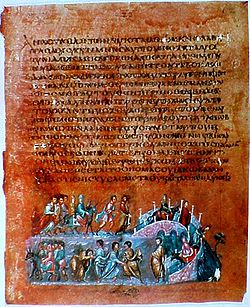
Vienna Genesis
Encyclopedia

Illuminated manuscript
An illuminated manuscript is a manuscript in which the text is supplemented by the addition of decoration, such as decorated initials, borders and miniature illustrations...
, probably produced in Syria
Syria
Syria , officially the Syrian Arab Republic , is a country in Western Asia, bordering Lebanon and the Mediterranean Sea to the West, Turkey to the north, Iraq to the east, Jordan to the south, and Israel to the southwest....
in the first half of the 6th Century. It is the oldest well-preserved, surviving, illustrated biblical codex
Codex
A codex is a book in the format used for modern books, with multiple quires or gatherings typically bound together and given a cover.Developed by the Romans from wooden writing tablets, its gradual replacement...
.
Description
The text is a fragment of the Book of Genesis in the Greek Septuagint translation. The text is frequently abbreviated. There are twenty-four surviving folioBookbinding
Bookbinding is the process of physically assembling a book from a number of folded or unfolded sheets of paper or other material. It usually involves attaching covers to the resulting text-block.-Origins of the book:...
s each with a miniatures at the bottom of both sides. It is thought that there were originally about ninety-six folios and 192 illustrations. It is written in uncial
Uncial
Uncial is a majuscule script commonly used from the 3rd to 8th centuries AD by Latin and Greek scribes. Uncial letters are written in either Greek, Latin, or Gothic.-Development:...
s with silver ink on calfskin parchment dyed a rich purple. This shade of purple dye was also used to dye imperial cloth.
The initial iota
Iota
Iota is the ninth letter of the Greek alphabet. In the system of Greek numerals it has a value of 10. It was derived from the Phoenician letter Yodh . Letters that arose from this letter include the Roman I and J and the Cyrillic І , Yi , Je , and iotified letters .Iota represents...
and upsilon
Upsilon
Upsilon is the 20th letter of the Greek alphabet. In the system of Greek numerals it has a value of 400. It is derived from the Phoenician waw. The name of the letter is pronounced in Modern Greek, and in English , , or...
have the diaeresis
Diaeresis
Diaeresis or dieresis may refer to:* Diaeresis , pronunciation of vowels in a diphthong separately, or the division made in a line of poetry when the end of a foot coincides with the end of a word...
.
The illustrations are done in a naturalistic style common to Roman painting of the period. The manuscript's illustrations are, in format, transitional between those found in scrolls and later images found in codices. Each illustration is painted at the bottom of a single page. However, within a single illustration, two or more episodes from a story may be included, so that the same person may be represented multiple times within a single illustration. There are both framed and unframed illustrations. The illustrations contain incidents and people not mentioned in the text of Genesis. These incidents are thought to have been derived from popular elaborations of the story or from a Jewish paraphrase of the text.
The Vienna Genesis may have been produced in the same period and place as the Rossano Gospels
Rossano Gospels
The Rossano Gospels, designated by 042 or Σ , ε 18 , at the Cathedral of Rossano in Italy, is a 6th century illuminated manuscript Gospel Book written following the reconquest of the Italian peninsula by the Byzantine Empire...
and the Sinope Gospels
Sinope Gospels
The Sinope Gospels, designated by O or 023 , ε 21 , also known as the Codex Sinopensis, is a fragment of a 6th century illuminated Greek Gospel Book. Along with the Rossano Gospels, the Sinope Gospels has been dated, on the basis of the style of the miniatures, to the mid-6th century...
.
See also
- Early Christian art and architectureEarly Christian art and architectureEarly Christian art and architecture is the art produced by Christians or under Christian patronage from about the year 100 to about the year 500. Prior to 100 there is no surviving art that can be called Christian with absolute certainty...
- Codex Cottonianus – another illuminated Greek manuscript of the Book of Genesis
Further reading
- Die Wiener Genesis, hrsg. von Wilhelm von Hartel und Franz Wickhoff, in: Jahrbuch der kunsthistorischen Sammlungen des Allerhöchsten Kaiserhauses, 15/16, 1895; Neudr. Graz 1970.
- Calkins, Robert G. Illuminated Manuscripts of the Middle Ages. Ithaca, New York: Cornell University Press, 1983. pages 21–22.
- Walther, Ingo F. and Norbert Wolf. Codices Illustres: The world's most famous illuminated manuscripts, 400 to 1600. Köln, TASCHEN, 2005.
- Weitzmann, Kurt. Late Antique and Early Christian Book Illumination. New York: George Braziller, 1977.
- Zimmermann, Barbara. Die Wiener Genesis im Rahmen der antiken Buchmalerei. Ikonographie, Darstellung, Illustrationsverfahren und Aussageintention. Wiesbaden: Reichert, 2003.

